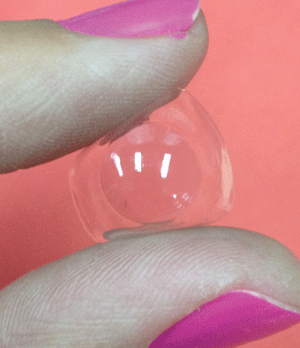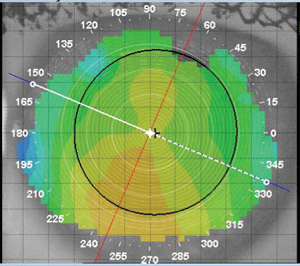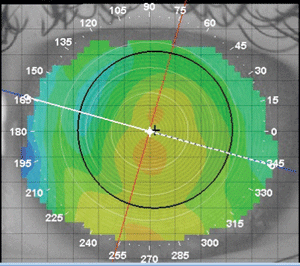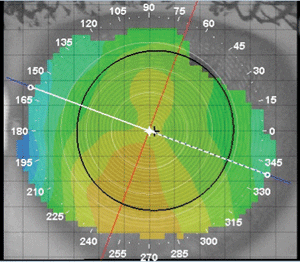
|
If you determine a patient is a good candidate for hybrid lenses, you can perform a trial lens fitting in the office, or order empirically using keratometry values and refraction. To order a multifocal hybrid empirically, you will also need to know eye dominance and add power.
 |
|
| Fig 1. Hybrid lens: GP center and soft skirt. |
Candidate Selection
Who is a good candidate for hybrid lenses? The many likely patient profiles include:
• Patients with regular corneal astigmatism.
• Patients complaining of lens rotation or fluctuating vision with soft toric lenses.
• Patients interested in GP lenses, but concerned about the comfort.
• Presbyopic patients with astigmatism.
• Soft multifocal patients looking for better vision.
• Irregular cornea patients looking to try other contact lens options.
Pros and Cons
Of course, every patient has specific needs and goals that affect the choice of lens design. What are the pros and cons of hybrids?
• Advantages of hybrid lenses: Hybrid lenses are great for patients with astigmatism, as the GP lens is able to mask most, if not all, of the corneal astigmatism. Hybrid multifocal designs give patients the option to reduce their dependency on glasses. Since hybrid lenses are created from exact keratometry values and glasses prescription, the patient’s vision is likely to be crisp and the comfort should be good.
Another great value to hybrids is that the lenses are not available at discounted contact lens suppliers or online. This means that the patient must purchase the lenses from your office and keeps patient retention high. The price of conventional hybrid lenses is very comparable to soft multifocals or GP multifocals, so patients do not get “sticker shock” when outlining the costs associated with hybrid lenses. Something unique that SynergEyes offers ECPs is a chair-side tool that explains the benefits of hybrid lenses and how they compare to traditional soft contact lenses.
A fabulous resource that SynergEyes offers is something called the Duette hotline. This is a phone line that patients or practitioners can call 24 hours a day, seven days a week. It is a great resource for patients that may be having problems such as with lens insertion and removal. Letting patients know that there is always someone to help them, in case the need arises, gives anxious patients some relief. Patients who are on the fence about trying a new lens modality may find comfort in the fact that there is always someone to help them if necessary.
• Disadvantages of hybrid lenses: Hybrid lenses do not correct for lenticular astigmatism; keep this in mind when comparing keratometry/topography values with the patient’s spectacle refraction. If there is significant residual astigmatism (> 0.50 D), you may want to reconsider. As for pricing, if you choose to pursue a diagnostic fitting in office, this will require more chair time and the fitting fees will generally need to reflect this.
Hybrid lens wearers will need proper training with insertion, removal and lens care. This new modality is easy for some and difficult for others. If your patient is unwilling to learn about a new lens modality, a hybrid lens may not be the best option. Hybrid lenses have the possibility of flattening the cornea over time, even if the contact lens fit is perfect in the beginning (see case report).

| |
| Fig 2. NW topography before Duette. | |
 | |
| Fig 3. NW topography showing flattening after wearing Duette. | |
 | |
| Fig 4. NW topography after discontinuing Duette (appears similar to her original topography). |
Case Report
NW, a 25-year-old female, presented for a comprehensive eye exam and contact lens fit. She complained of occasional lens rotation OS, which caused intermittent blurry vision. She was currently wearing standard soft toric contact lenses.
Manifest refraction was -4.00 -1.25x180 OD (20/20), -4.00 -1.75x160 (20/20). After trialing two additional soft toric lens options over the course of three weeks, the problem persisted. At this point, I decided to try Duette HD on the OS. Topography showed 45.5@067 and 43.9@157 (Figure 2). I felt this patient was an excellent candidate because all her astigmatism was corneal and her complaint of lens rotation should be solved with a hybrid lens. Using the online calculator, I ordered for the left eye: Duette HD 7.7 BC / -4.00 / 8.4 skirt curve.
Upon dispensing, the lens was centered and moved about 0.5mm with blink. The base curve and prescription were correct, as per the fitting guide. Her vision was 20/20 through the lens. She felt the lens comfort was good, even though she described a very mild foreign body sensation. She was trained with insertion, removal, and lens care.
NW presented for a one-week follow up and was very excited about the comfort and the vision of the lens. She was still seeing 20/20 with no over-refraction. With the lens removed, there was no corneal staining and all ocular structures were healthy and normal. She then returned for a one-month follow up and no issues with her hybrid lens. Once again, the lens was removed and there were no corneal defects an all ocular health was normal.
NW presented back to the clinic about four months after her dispensing visit complaining of blurred vision again OS. Her vision was 20/50 with the hybrid lens. The lens fit appeared to be unchanged and there were no major scratches or deposits on the lens.
With the lens removed, there was mild SPK centrally and also around the GP/soft junction of the lens. Topography was taken and a change in the pattern of astigmatism was seen (Figure 3). In response to this change in her corneal shape, the prescription was changed. Her manifest refraction without the lens for the OS was -4.50 -0.50 x 165 (20/20). At this time, she was re-fit into another lens modality. Six months after the new modality, her corneal shape remains very stable to her original topography (Figure 4).
Practice Pointers
Hybrid contact lenses do work well for many patients, but be careful of potential flattening or altering of corneal shape as outlined in this case report. Frequent monitoring of the patient may be necessary to recheck their vision and eye health. In my personal experience, hybrid lenses have been a huge value to my practice; they satisfy many patients when other lens modalities fail. The optics for their multifocals have proven to be great for patients who may have failed in other multifocals. In other cases, patients do not adapt to the comfort or their vision is still not up to their standards.
I think hybrid lenses are worth having in every practice, because that patient who has failed in every other design may love their vision in a hybrid lens. Since their pricing is competitive with custom toric lenses, hybrid lenses may be the first lens of choice for many practitioners or patients with normal corneal astigmatism.
If you are nervous or skeptical, try ordering empirically and think of it as a “custom diagnostic lens.” This lens may work right off the bat, or may need minor tweaking to achieve the best possible fit and vision. In either case, many patients are very happy with the comfort and vision of the lens, so why not be that doctor who is seen as using cutting edge technology?


